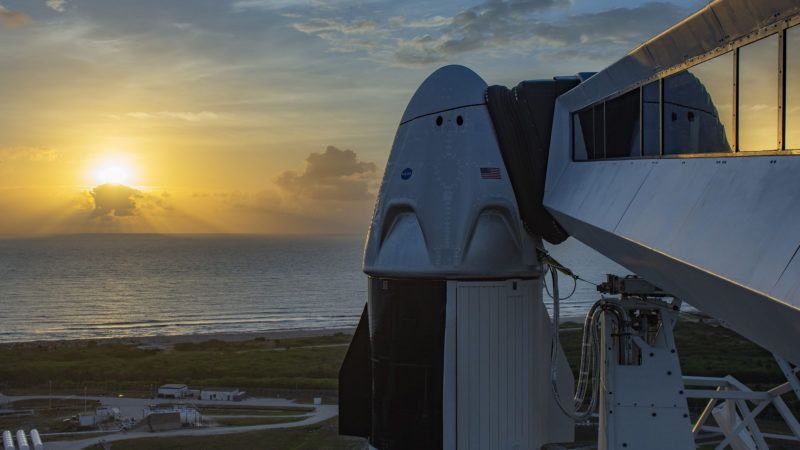NASA Astronauts Hitch a Ride With Elon Musk's SpaceX
Today's Crew Dragon launch marks the first time a private company has sent humans into orbit.

NASA is back in the business of carrying astronauts into space, and it's relying on private enterprise to get the job done.
At 3:22 P.M. Eastern time today, NASA astronauts Doug Hurley and Bob Behnken were carried from Kennedy Space Center in Florida into low Earth orbit inside SpaceX's Crew Dragon vehicle and propelled by the company's Falcon 9 rocket. It marks the first time NASA astronauts have been launched into space from the U.S. since the last flight of the agency's Space Shuttle program in 2011. It's also the first time a privately-owned craft has carried humans into orbit.
"We are once again launching American astronauts on American rockets from American soil," said NASA Administrator Jim Bridenstine in a Tuesday press conference. "This is a big moment in time. It's been nine years since we've had this opportunity."
The launch was originally scheduled for Wednesday, but was delayed because of weather.
The Crew Dragon vehicle will now carry the two astronauts to the International Space Station (ISS), where they will stay for anywhere from 30 days to four months.
Liftoff! pic.twitter.com/DRBfdUM7JA
— SpaceX (@SpaceX) May 30, 2020
Since the Shuttle program was axed nearly a decade ago, NASA has been paying the Russian government to carry its astronauts to space, which has cost as much as $86 million per seat, according to CNN. Today's mission relieves the U.S. of having to rely on a foreign government to get its astronauts into space. It also relieves NASA of having to rely on government-owned spacecraft.
The success of the Crew Dragon mission is a vindication of the space agency's decade-and-a-half long transition to a commercial space model that has spurred private innovation and saves taxpayers money.
Technically, collaborations between NASA and private industry have gone back decades, with big private defense contractors like Boeing and Lockheed Martin helping to design the rockets and vehicles that carry cargo and crew into space. Those collaborations, however, were typically conducted through "cost-plus" contracts. These arrangements, as Ars Technica's Eric Berger describes in a detailed history of NASA's move to commercial space, were a recipe for cost overruns:
"For big human spaceflight projects, NASA engineers had decided precisely what they needed, selected a contractor to build it, and then monitored every step with paperwork in triplicate. For this, the contractor got reimbursed for its costs, plus a generous fee. If a vehicle ran five years late and doubled its original budget, NASA was on the hook for cost overruns. This tended to not encourage on-time delivery, but eventually the government got what it wanted."
The SpaceX launch that occurred today relied on a "fixed-price" model, where NASA would specify what service it wanted and the price it would pay for its development. Private companies would then compete for those contracts. As part of its "buy a ticket, not a vehicle" motto, NASA would effectively be a customer of these private companies, who would own and operate their craft.
This new approach got started in earnest back in 2005 when NASA announced it would award $500 million to two companies to develop cargo-carrying vehicles to low Earth orbit as part of its Commercial Orbital Transportation Services (COTS) program. Space X and Orbital Services eventually received the initial contracts under COTS.
In 2012, SpaceX—founded by former PayPal CEO Elon Musk—became the first private company to deliver supplies to the ISS as part of the COTS program.
The success of this program later led to the creation of the Commercial Crew Program (CCP), which would focus on developing systems for human space flight. In 2014, NASA awarded both SpaceX and Boeing contracts of $2.6 billion and $4.2 billion respectively to build and operate crew launch systems. That's a screaming bargain compared to the cost of more directly government-managed space development programs. Berger, at Ars Technica, notes one 2009 estimate showing that it would cost the government $34.5 billion to develop the Ares I rocket and Orion crew-carrying spacecraft as part of NASA's now cancelled-Constellation program.
"We were effectively doing what the Constellation Program was doing with about the same amount of money, total, that they were burning in a single month," said one NASA engineer who was assigned to work with SpaceX on their Cargo Dragon project.
The Space Launch System NASA adopted to replace the Constellation Program, and which is being done on the traditional cost-plus contract model, has also suffered from missed deadlines and cost overruns.
While the free market futurist vision of private moon colonies is still probably a few decades away, the Crew Dragon launch is an important milestone and a useful example of how to successfully contract out government functions to private companies.
Also, check out Reason's interview with aerospace pioneer Burt Rutan on the dawn of private space travel:
Rent Free is a weekly newsletter from Christian Britschgi on urbanism and the fight for less regulation, more housing, more property rights, and more freedom in America's cities.



Show Comments (152)